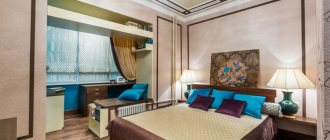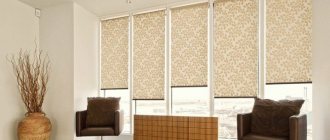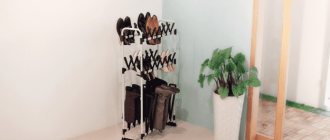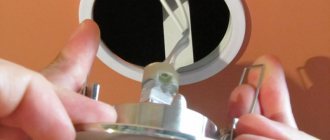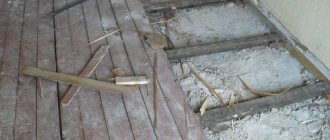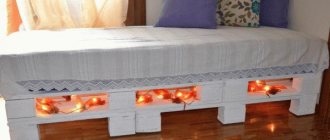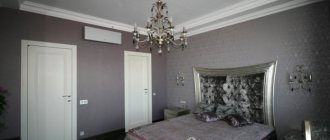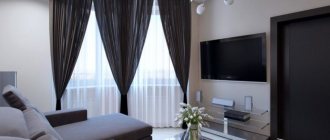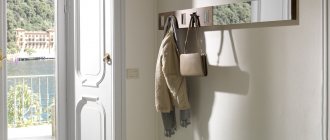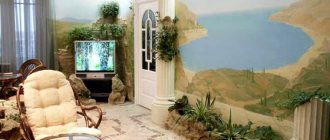Automatic lighting
Lighting of staircase structures is most often necessary only when a person moves along it.
The exception is the emergency lighting of the stairs, which, when switched on, is constantly on. To solve the problem of saving electricity, without sacrificing safety and comfort, automatic systems for turning on and off lights on staircase structures are often used. The video in this article will clearly demonstrate the operation of such machines.
Automatic systems are programmed for the level of general illumination of the room and come into operation when staircase lighting becomes necessary.
Staircase lighting scheme
Automatic staircase lighting is provided using special sensors that respond to movement or sound. Such a system can also be controlled using a remote control.
Motion sensors
Built-in motion sensors for staircase lighting turn on the light on the staircase system when a moving object appears within a certain range of the room. Stopping movement helps turn off the light sources after a certain period of time.
Noise sensors
Automatic acoustic systems respond to the noise level in the room. Staircase lighting in an apartment building is often performed using just such devices.
Sound sensor on stairs
Automatic lighting control systems not only help save energy, but also provide convenience for going up and down stairs, since there is no need to search for a switch in a dark room.
The price of such systems can be quite high. But their cost will quickly pay off due to the saved costs on paying electricity bills. Manufacturers' instructions advise protecting automatic sensors from voltage surges.
Other types of staircase lighting controls
You can control the staircase lighting in other ways:
- Radio controlled switches can be less expensive. They do not require electrical wiring, which is very convenient when installing them in finished rooms. Such a system consists of the switch itself and radio signal receivers. The first element is fixed on the wall or fence. Receivers are installed on lighting fixtures. The range of these systems may vary. The disadvantage is the periodic replacement of batteries.
- You can also install keys with a timer on the switches. They are programmed for a certain period of time during which the staircase structure is illuminated. Then the light turns off automatically.
- Automatic lighting of staircase steps sequentially turns on the illumination of each step as you move along the staircase structure. Motion sensors are installed in front of the first and last steps of the stairs. The backlight turns on automatically when you cross its coverage area. You can configure the staircase lighting controller with specified parameters for the number of steps, light brightness, and speed of turning the lighting on and off.
If you want to make automatic staircase lighting, then the choice of devices for this is currently quite diverse.
Light Source Control
The lighting design of the staircase system significantly affects traffic safety and creates its unique appearance.
Night staircase design
The answer to the question: how to make staircase lighting, everyone chooses depending on their individual design and taste. The variety of interior solutions that can be achieved using lighting structures will satisfy any needs. The main thing is not to forget about safety. And then the staircase will become a decoration of the whole house.
Lighting control methods, advantages and disadvantages
Naturally, the abundance of lamps and their installation options provide various ways to manage this diversity.
Comfortable lighting “automatically”
Automatic lighting systems are equipped with sensors and controllers. Motion sensors react to a moving object and are installed at the beginning/end of the stairs. When mounting on a wall, choose devices with a viewing angle of 180°, and when mounting on the ceiling - 360°. Typically, the operating range of devices is no more than 12 meters.
Advantages: energy savings (since the lamps do not work all the time), no need to fumble around the wall in the dark looking for a switch or try to remember to turn off the lights after walking up the stairs, the system works on classic lamps or LED strips.
Disadvantages: sensitivity to voltage surges and, as a result, breakdowns or incorrect operation; the presence of animals in the house leads to unnecessary operation of the system.
The system can be configured according to the following operating modes: quick turn-on, illumination of all steps simultaneously or alternately, constant low-level lighting of steps. If you want the system to turn on automatically at night, it is connected to a light sensor. To install and configure the correct operation of the system, it is advisable to use the services of professionals.
Manual backlight control
This is the most common lighting control option, which is convenient when equipping simple (single-flight) structures. The staircase lighting scheme is quite simple: the keys are installed on the first and last steps. If the house has several floors, then switches are mounted on each floor. Similar product models will be an excellent way to illuminate a basement or attic staircase or steps to the basement or attic floors.
Advantages: low cost of components, ability to use backlighting as needed. The disadvantages include the need to pre-install the wiring, which is optimal for equipping stairs located only near the walls.
A staircase in a single stylistic solution with the room, and properly equipped with lamps, will be a reliable “helper” in the dark and an effective design element during the day.
Primary requirements
Types and features of escape stairs
The lighting scheme may include only one type of lighting fixtures, or a whole combination of fixtures.
How to do
In any case, there are basic requirements that must be met:
- Safety and traffic comfort are the main requirements that the entire lighting system must fulfill. It is necessary that both the entire structure and its individual elements are well illuminated.
- Illumination should be uniform.
- The light source should not blind a person's eyes.
The selection of lighting devices must be based on:
- General level of illumination in the room;
- Lamp power;
- Directions of the light beam at the light source.
Compliance with basic safety measures will help avoid injuries during use and make movement around it more convenient.
Daylight
The lamps used must be safe and easy to use.
Illuminated staircase design
Lamps should fit into the overall design of the staircase and become its decoration. Their choice depends on the style of the interior. If you like classics, then wrought-iron sconces will suit you, each of which has two lampshades, plain or with a floral print. Such devices are placed between paintings in gold frames. If there is a lot of wood in the interior, look for lamps with wooden lampshades.
Square spotlights will fit into a Scandinavian interior. They can be built into steps or installed along the stairs. They are also suitable for loft and minimalism style. For the latter, select square light sources in steel frames. If several light sources are used, they should all be in the same style and complement each other.
Working methods
Polish chandeliers
Original lighting can be done in 2 ways. One is from the switch; for comfort, you can install switches at the bottom of the stairs and at the top.
It will be more economical. Connecting an intelligent circuit is more efficient. It is necessary to install sensors on the bottom step and the top.
If a person steps on the stairs, the controller will immediately receive a signal and launch the light elements.
The second method is more used in basements. When the door opens, the sound will be detected by the sensor and the backlight will turn on.
Another motion sensor will turn on the lights when a person approaches the stairs. This is a great energy saving. To prevent the sensor from reacting during the day, a photocell is installed - this is a “smart lighting system”.
No. 1. The main components of the ladder and requirements for them
The staircase design includes the following elements:
- Steps are an essential part of any staircase. They consist of a tread , a horizontal surface, and a riser , a vertical part that serves as additional support. Some types of stairs may not have risers. The width of the tread is selected taking into account the convenience of placing the foot on it (the optimal value is 30 cm), the length can range from 90 to 150 cm and depends on many factors. The height of the riser is usually 15-20 cm. The width of the tread in spiral staircases at the two ends is different, it is important that in the central part this parameter is at least 25 cm;
- support beams - elements used to fasten steps. For marching stairs, a stringer and a bowstring are used. The stringer is a monolithic beam that supports the steps from below, the bowstring is the end beam. For spiral staircases, the supporting element is a pillar to which all steps are attached;
- railing ensure safety of movement on stairs and consist of balusters and handrails. Balusters serve as supports, fencing and decoration.
Lighting with lamps
Staircase lighting should be good. At the same time, it is not very bright, so as not to dazzle, and is convenient to use. If your staircase connects to a wall, you can use wall lights or sconces to illuminate it.
They will not only serve as lighting for the staircase, but also decorate your wall. They will also add more comfort to the atmosphere of your home. You can also use hanging light sources. If selected correctly, they will not spoil the interior of the room at all.
Lamps are:
- External.
- Built into the steps.
- Built into balusters or railings.
The lamps can be installed independently. But if you do not have experience with electricity, it is better not to take risks, but to seek the help of specialists.
Staircase lighting in a house can be done using neon, halogen, or LED light sources.
Proper staircase lighting: advice from professionals (23 photos)
Not a single owner of a house or two-story apartment will argue that the staircase should not only be beautiful, but, above all, safe. It is high-quality and good lighting that creates comfort and minimizes the risk of stumbling in the dark or falling.
Daylighting the stairs in the house partially solves the problem of light. Therefore, it is important to consider the location of the structure relative to windows and doorways. Even if it is located next to a window, then on cloudy days, and especially at night, there is a need for artificial lighting of the stairs to the second floor. The lighting should not only be functional, but at the same time organically combine with the shapes and design of the structure. It is necessary to decide on the lighting option at the stages of planning a house and choosing the type of staircase.
LED backlight softness, smoothness, benefit
The light source in this type of lighting is LED strip. The light it emits is soft tones - amber, turquoise, white. It is very easy to choose lighting of the color that you like, and which, even in semi-darkness, harmonizes with the interior.
There is no need to worry that LED staircase lighting will dramatically increase your electricity bills: it consumes 20 times less energy than a traditional incandescent light bulb. Moreover: during the day, when there is enough natural light, the system turns off - the light sensor protects you from unnecessary expenses.
By the way, the LED lighting for the stairs is customizable, which makes it convenient for you and your family. There are enough opportunities. Thus, you can adjust the speed at which the stage lighting turns on and its duration. If you like, the staircase can be fully illuminated as you approach, or the steps can be turned on in groups (this is especially convenient if the flight of stairs is long).
In principle, the possibilities begin when you purchase the system. If you know a little about electrical engineering, you can install it yourself - it's easy. If electricity is something you don’t understand, you can order the installation of a turnkey system, and the company’s specialists will equip your staircase with lighting quickly, efficiently, and even with a guarantee. You also don’t have to worry if your staircase has special features: automatic lighting is installed on staircase structures of different types. Dimensions are also not important: you can choose a kit for lighting a staircase with up to 16 steps, or a kit for a large staircase (24 steps).
And, of course, there is no need to worry that when washing the steps, water will seep into the LED strip: it is securely packaged in a silicone shell.
By equipping your staircase with lighting, you gain a lot. First, you get rid of the tension that arose every time you had to go up or down numerous steps in the dark. Secondly, your interior ceases to be static, it comes to life and changes, becoming spectacular. And all this gives you peace and pleasure. Moreover, every day, for many years (at least ten - according to the service life of the backlight system). Is it possible to refuse this?
How to illuminate staircase steps: system features, advantages, technical solutions
A comfortable and beautiful staircase is one of the main elements of the interior of a two- or three-story country house. In addition to beauty, the stairs must be safe, especially when children and elderly people move along them at night. For this purpose, the steps are illuminated. How to make an LED staircase lighting system with your own hands and what will you need to buy for this? All the answers are in our material!
- Why do you need staircase lighting?
- Where to start making a staircase with lighting
- 3 ideas for making stair step lighting
- How does automatic staircase lighting work?
- What equipment to choose for staircase lighting
- How to install LEDs on stair steps
Lighting the stairs in the house how to control the lamps
We are all accustomed to standard lighting control using conventional key switches. It is relatively convenient, practical and, most importantly, not very expensive. The only “but” in this method of controlling light on the stairs is that it is one-sided - in the sense that a regular switch can only be placed at the top or bottom of the flight of stairs. The inconveniences of using them are very obvious - once you turn on the light at the top of the stairs, you can’t turn it off at the bottom. It is for this reason that on flights of stairs, light control is performed using other types of switches.
- Pass-through switch. This device works in pairs - one key is installed at the top, and the second at the bottom of the stairs. Both buttons work independently of each other and can independently turn the light on and off, regardless of the position in which each of them is located. The thing is very convenient. By the way, like ordinary ones, pass-through switches can be one- or two-key (there are even three-key), touch and mechanical, with or without backlight. In general, the choice is very rich. So if there are three groups of lighting on your flight of stairs, then it is quite possible to control them using two- or three-key pass-through switches.
- Staircase lighting with motion sensor. This method of controlling the lighting on the stairs does not require any human intervention at all - or rather, the person does not have to press anything. A special sensor that reacts to the presence of moving objects is responsible for turning the lighting devices on and off. When the motion sensor detects a person, it sends a command to the electronic key, which closes the lighting circuit - after the sensor stops detecting movement, the circuit opens and the light turns off. The delay time can be adjusted - that is, the lighting will turn off after a certain time from the moment the sensor stops detecting movement. As a rule, this method of controlling lighting on stairs uses a pair of sensors - one is mounted at the bottom and the other at the top of the flight of stairs.
By and large, setting up automatic control of lighting on the stairs with your own hands today is quite easy - there are quite a lot of different lighting devices on sale that already have a motion sensor. Such lighting fixtures can be connected like standard sockets, bypassing the switch, which is not very difficult to do with your own hands.
And in conclusion to the topic of what staircase lighting can be, I’ll say a few words about the concept of hidden lighting - this is when lighting fixtures are hidden, and they are either not visible at all, or they are noticeable when a person knows about their presence. It is standard practice to produce such lighting using LED strips, but there is another interesting option - fiber optic lamps. Its meaning is to transmit the light flux through an optical cable, which can have different thicknesses of fibers - that is, a light generator (projector) is mounted in a hidden place, from which thin fibers diverge to the right places, which can be released anywhere on the stairs. These fibers become a source of light only when light is supplied to them - if there is no light, then the fibers, due to their structure, are practically invisible.
Spiral staircase
As already mentioned, a spiral staircase in a private house takes up the least amount of space. But it has a serious drawback: it is uncomfortable to walk on, and it is almost impossible to lift anything bulky to the second floor. So they are not very popular, although they look good and fit well into any interior.
Calculation features
When designing a spiral staircase, it must be taken into account that in some positions there are other steps above your head. Therefore, it will not be possible to make small risers
The next feature is that the steps are all unequal in width - narrower on one side, wider on the other. The narrow part is attached to the central support (post), the wide part is attached to the walls or balusters. The standard for the width of the tread is measured in the middle part, and the wide part should not be more than 40 cm.
The span width is from 50 cm to 100 cm. The entire structure is doubled - a square with a side of 100 cm to 200 cm is required.
Prefabricated column design
This type of spiral staircase is the easiest to make: a pipe is placed on which wooden elements are placed - steps, intermediate cylinders, etc.
The device of a spiral staircase on the central pillar
If you look in more detail, in addition to a metal pipe (in this case with a diameter of 40 mm), steps and balusters (available in any design), there are turned wooden cylinders (segments) that set the distance from one step to another.
Elements of a spiral wooden staircase
On the other hand, the distance between the steps is maintained using cuts on the balusters. The steps are attached to these grooves (with glue + fasteners).
The same device, but in metal
Do-it-yourself installation of a staircase to the second floor begins with the installation of a pillar. A hole equal to the diameter of the pillar is made in the floor of the first floor and the ceiling of the second. We insert the pipe into the hole, put on the enlarged washer, and tighten the nut. Further assembly is simple: the corresponding elements are mounted on the rod, and in parallel with the installation of the step, a baluster is placed and secured. The dimensions of the steps for this spiral staircase with the given parameters are in the drawing.
Drawing of elements of a spiral staircase with dimensions
The steps are cut from laminated boards or furniture boards. You can use solid wood, but of furniture quality, that is, without any defects and dried, with a humidity of no more than 8-12%. Although laminated wood is considered more reliable: it will definitely not be damaged and will not crack when dried.
For an example of assembling such a design, see the video. It has a prefabricated pole, but you can also use a solid one, although assembling the steps will be inconvenient - you will have to climb the stairs every time.
The design of a metal spiral staircase is presented in the following video fragment. For those who are familiar with welding, this option will be easier.
Spiral staircase to the second floor: photos of interesting options
Spiral staircases can have a futuristic look. Such models fit well into the styles of minimalism, hi-tech and other modern trends in interior design. With or without railings - the choice is yours
In the photo on the right, a wooden spiral staircase on a curved stringer is a difficult element to execute. The original shape of the steps in the form of a semicircle is very comfortable when walking. Forged twisted staircases are a classic of the genre. With the same design, the impression may be different. Color design is also important.
Selection of lamps
When you are wondering which lamp to choose and which one is easier to install yourself, a huge assortment appears before you. Of the many varieties, halogen and LED lamps are best suited. We will advise you to use the LED system, since with its help you can make the lighting more colorful and beautiful. They are also much easier to install yourself, thanks to their simple design.
The main indicator of the quality of a lamp for this application is its strength and wear resistance. Manufacturers specializing in the production of lamps for stairs usually produce them in a durable housing, either metal or dense plastic. LED lamps are better suited than others; there are simply no breakable elements. Built-in ones must be shock-resistant, since someone could step on them and there is a risk of an object falling on them.
The intensity of the luminous flux should not only be within normal limits, but also fit harmoniously into the decor of your home. Brighter light has the effect of expanding space, and soft, dim light will add calmness and help you relax faster.
Different types of lighting in the house
When choosing lighting, you should also consider what your staircase is made of. The color design of the housing must be combined with the color of the materials, and the color of the emitted light must be harmonious with the environment. If recessed luminaires are installed in wood, their housing should not overheat too much, as elevated temperatures can cause a fire.
When making staircase lighting with your own hands, you can install both centralized and remote control. It is possible to supplement the lighting elements with a motion sensor, so they will turn on when necessary.
Centralized control involves installing a switch, or a group of switches. Some will include recessed lights, others will include general lighting. Or one button for all the lighting at once.
Summarize
Lighting the staircase of your home is a creative process, although it is quite simple, but it must be approached with understanding and complete seriousness. Only a properly lit stairwell will help make your life more comfortable, and getting up to the bedroom after a hard day at work will not be a torment for you, but the beginning of your relaxation.
By correctly placing lamps on the floor, railings, steps and walls, and harmoniously choosing their colors, you will make your staircase the highlight of your interior. The most important thing is to always remember that in this matter you are not limited by any standards, use your creativity and imagination, then you can achieve an excellent result.
No. 3. Marching stairs: requirements and features
A flight of stairs is the most common and easiest to install staircase option. It is a continuous series of steps from one floor to another or to the landing. Such designs most accurately take into account the biomechanics of human movement, and therefore are considered the most convenient and safe for movement. A significant drawback is that their arrangement will require a lot of space, but this minus can be turned into a plus: the space under the stairs can be used usefully.
A march is a continuous series of steps. It is recommended to make no more than 10 steps (maximum 17) in one flight to ensure the most comfortable ascent and descent. If this number of steps is not enough, then it is better to arrange two or more flights, and make a landing between them: its width is equal to the width of the steps, and the length should be a multiple of the step. Two- and three-flight staircases will take up less space if the flights are located not in one direction, but at an angle.
Depending on the layout, flight stairs can be:
- straight – the most convenient and durable option;
- rotary ones do not lose much in terms of convenience, but they allow you to more efficiently use the space of the house, which is very important when there is not an abundance of it.
Turning stairs are divided into several types:
- L-shaped (quarter turn) connects two flights of stairs at right angles;
- U-shaped (half-revolving) involves connecting marches at an angle of 180 degrees, can be intermediate (if located between floors) or storey;
- The 3-section consists of 3 flights, which are located at an angle of 90 degrees to each other;
- trapezoidal is distinguished by the connection of marches not at right angles. Used in houses with non-standard layouts or, if necessary, to implement a bold design idea;
- rounded (curved);
- combined may include spans connected in different ways.
In addition, flight stairs can be:
- closed;
- open.
If there is a riser under the tread, then the staircase is called closed . These are staircases that are more durable and feel safer. Designs without risers are called open : they are lighter and do not visually clutter up the space of the house.
According to the type of construction, staircases are divided into the following types:
- Staircases on stringers have a sawtooth shape in appearance and are a monolithic beam, on top of which finishing material for steps and risers is laid
- stairs on a bowstring . A bowstring is an inclined beam that runs the entire length of the staircase. On its inner side there are grooves where the steps are mounted.
To make marching stairs, you can use almost any material: wood, concrete, metal, stone, glass, or combine them.
Lamps for stairs
For a multi-level apartment or a multi-storey private house, the staircase is an important part of the interior. Many people strive to use it not only as a functional item, but also as a decorative structure.
Sometimes they try to highlight it using backlighting. They also take into account the fact that household members use the stairs at any time of the day, so lamps are an integral part of such a design.
Illumination will make moving around more comfortable and safe. Separate staircase lighting is very popular now.
Peculiarities
Staircase lights should be quite bright, but they should not be blinding. Their peculiarity is that they create soft diffused light, as well as a minimum of shadows.
To illuminate the stairs leading to the second floor, it is better to use spotlights, which must be positioned correctly. There should be a distance between them of no more than 1 m. The optimal distance is 50-70 cm. Such lamps should be located along the entire length of the span.
In a private house, not only spotlights, but also wall sconces are used to illuminate steps. Such lighting is very reliable, but usually the sconce shines very brightly
Therefore, it is important to select the required brightness level.
Floor spotlights can highlight a beautiful massive staircase in a cottage. They have an unusual design and are located vertically between the spans
This lighting looks very beautiful and romantic. Subdued light will become the highlight of your interior and will perfectly illuminate the steps.
Varieties
Manufacturers now offer many types of lamps for stairs. They allow you to improve lighting in the house and make passage through it safer at any time of the day. The following types of staircase lighting are distinguished.
LED
LED lamps are the most popular. Many people use them to illuminate the stairs. Moreover, in this case, both spotlights in the form of light bulbs and LED strips are used, which can easily be used to hang the stairs. LED lamps are quite durable, their service life is more than five years.
They are completely safe because they do not heat up at all during operation. These products can be battery operated or rechargeable. By replacing the battery, you can extend their service life.
Manufacturers are now making lamps with LEDs, which are also equipped with motion sensors. This is an excellent “smart” lighting that not only looks impressive, but is also very practical. It allows you to reduce energy consumption, since the light bulbs will only turn on when someone moves on the stairs. They are very convenient, since you won’t have to look for a switch on the walls with your hands in the dark for a long time. It will also be very easy for you to move up the stairs even when your hands are full.
These motion sensors are very easy to install. Very often, smart lamps are installed on steps in the place where you step with your feet. They are completely covered with aluminum mesh for protection.
They are very popular because they are very reliable and practical. Such products are usually made in the form of spotlights above the stairs. They can also be mounted on walls. The big advantage of such lamps is that you can choose any color of lighting. Moreover, it can be both warm and cold.
Such bulbs allow you to play with light, darkening or brightening one or another part of the staircase. They can also last a very long time and are completely safe for human health. This is a great energy saving option.
Lamps for stairs
Staircase lamps are a very important and functional element. They ensure safety when climbing in the dark. What types of lamps for stairs are there? How to choose the right devices and place them on the stairs? LED lights for illuminating steps in the house, as well as other stylish and practical lamp models.
Why do you need staircase lighting?
At first glance, it seems, of course, for beauty! See how impressive the staircase looks in the evening or at night with lighting.
Beauty is just one of the advantages of lighting. Proper staircase lighting simultaneously solves several important problems.
A staircase connects two floor spaces with each other. It turns out to be a high-altitude transition. When a person walks along this passage, he should feel safe. The longer the transition, the better it needs to be illuminated in the dark. Lighting improves the aesthetic perception of the staircase. Lighting can enhance the spatial effect of the staircase, for example, connecting the staircase with the rooms or, conversely, separating them.
Let's show how this works with examples.
Using lighting, you can “hide” the staircase or visually change its dimensions.
However, not all homeowners want to install a staircase with LED lighting in their cottage.
I don't think all this flickering on the stairs will lead to anything good. The light coming from bottom to top will attract the attention of children. They will play on the stairs. Yes, and I feel uncomfortable when light gets into my eyes. Here’s how I lit the staircase: I mounted 4 LED lamps on the ceiling with a power of 0.5 - 1 W each. The light falls from top to bottom. The lights turn on according to a timer when it starts to get dark. Very comfortable at night.
I've had staircase lighting for two years now. Very convenient when you go down at night.
Do you want to add a staircase to your home with a lighting system? Below we will talk about several options for lighting steps.
Lighting the stairs in the house, how to make it Instructions 100 photo examples
Lighting, which is mounted in the staircase, not only makes it a beautiful element of a modern interior, but also makes the steps safe in the dark.
However, in order for the lighting to perform all these functions, the backlight must be installed correctly.
How to organize staircase lighting?
There are different options for installing lamps on the stairs. First of all, they depend on the lighting device. So there are the following types of lighting for stairs:
- LED linear lamps,
- Neon lights,
- Hidden lighting.
Meanwhile, there are separate lamps that perform lighting functions. Such lighting devices include:
- Railing lighting or lamps mounted in the side elements of stairs,
- Lamps mounted on wall surfaces
- Pendant lamps.
When choosing how to decorate the staircase lighting, you must be guided by individual preferences, the design of the house and the expected effect.
Neon lighting has the advantage of maximum safety, long service life and soft light that is pleasing to the eye.
Spot halogen lamps have the advantage of uniform distribution of illumination, but you should not count on a long service life of such lamps.
The most convenient to use are LED lamps. Because they can work both from electricity and from batteries.
In addition, such lamps can be used for a long time without replacement, they are resistant to mechanical damage and they evenly illuminate the stairs.
Features of lighting of external stairs
If changes in temperature, humidity and other atmospheric influences are not particularly important for organizing the lighting of internal staircases, then external structures have their own characteristics.
- The power of outdoor light sources should be greater than that of indoor lamps.
- In the case of using general lanterns to illuminate the courtyard and stairs, their location should provide enough light for the entire system.
- Only lighting fixtures specifically designed for outdoor installation should be used. Lamps for lighting the stairs in them must be protected from atmospheric influences, that is, covered with shades.
- Electrical wiring is used with reinforced insulation that can withstand temperature changes and precipitation.
Original options
Lamps can be located:
- On the walls of the house;
- On the fence;
- Suspended from cables;
- Installed on poles.
Low columnar lighting structures are often used.
https://youtube.com/watch?v=CMlPUekL1S8
No. 6. Materials for making stairs for home
When designing a staircase, one of the first questions that arises is the material used. Of course, you need to take into account your own budget, tastes and style of home interior, but also do not forget that the chosen material must be durable, wear-resistant and easy to maintain.
Wooden staircase
The wooden staircase is a classic that never seems to go out of date. Wood can be used to make support elements, steps and handrails, and can be combined with other materials. Among the main advantages are naturalness and environmental friendliness, unique texture and beautiful natural color, warm non-slip surface, pleasant smell, light weight, relative ease of installation and accessibility. A wooden staircase will be an excellent addition to any interior, because due to the ease of processing and the presence of a mass of species of different shades, it is not difficult to create a structure that matches the idea.
The wood for stairs must be well dried and free from defects. As for the species , it is better to choose oak or larch: beech can become deformed under the influence of strong humidity, maple is prone to cracking and yellowing, and pine is very soft.
Metal staircase
Metal outperforms wood in terms of durability and wear resistance . Typically, stainless steel is used to make stairs, which can last up to 40-50 years, is durable and resistant to corrosion. The structure can be made entirely of metal, but today options combined with wood, stone, glass or plastic are increasingly common.
In addition to excellent performance qualities, the advantages of metal include flexibility and ductility, which makes it possible to create stairs of absolutely any shape. Not the highest cost should also be considered an advantage. Among the disadvantages is the cold and “noisy” surface of the metal, but this will be noticeable when using it as an independent material for decorating stairs.
The manufacture of a metal staircase, as a rule, includes a complex of complex welding works, so it is better to entrust this work to professionals. Today, such structures are made to order and also sold as a ready-made kit.
Wrought iron staircase
Ordinary metal stairs do not always fit well into classic interiors, and some people find their appearance too industrial. The solution is to use forging, which combines all the advantages of metal , but looks openwork and airy. With the help of forging you can create various ornaments; it is suitable for all types of stairs and goes well with wood and stone. The only negative is the high cost, because it is always manual labor-intensive work.
Concrete staircase
Concrete stairs are the most durable and reliable option. This is how staircases are made. The structures are cheap , but very heavy and bulky, so they are best used in large houses. It is better to build concrete stairs from ready-made elements at the stage of building a house, otherwise it can later be problematic to deliver the product to the installation site, and pouring the stairs on site is long and labor-intensive. Concrete stairs are often decorated with wood and metal.
Stone staircase
Only steps are usually made of stone. This design will become an expensive interior decoration, as it looks chic and is really not cheap. Natural rocks used include granite and quartzite , and less commonly marble. Durability, strength, resistance to abrasion, moisture and temperature changes, as well as ease of care and elegant appearance are the main advantages of stone . Disadvantages - heavy weight and price, so natural stone is often replaced with artificial stone on a concrete basis . It is practically not inferior in durability and strength to natural.
Glass staircase
Stairs made of glass are airy, almost invisible and stylish. They fit perfectly into high-tech and modern , but along with a chic look you will have to put up with some inconveniences: a slippery surface and the need for constant careful maintenance. Of course, for the construction of such stairs they use laminated or tempered glass , which is highly durable, but even this can crack if hit at the end. Acrylic glass, which is considered stronger and lighter, may turn yellow over time. Glass steps go well with chromed metal.
